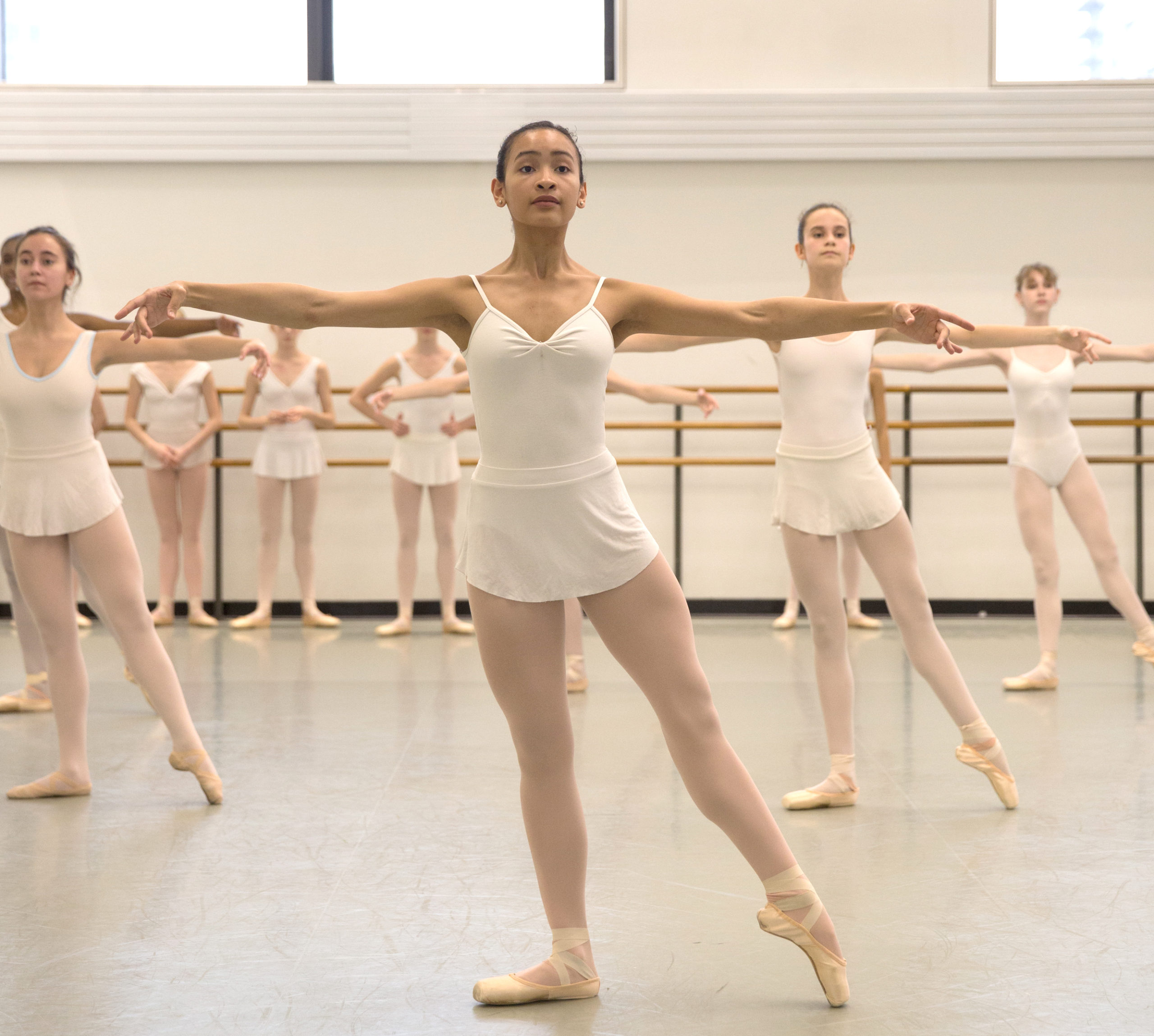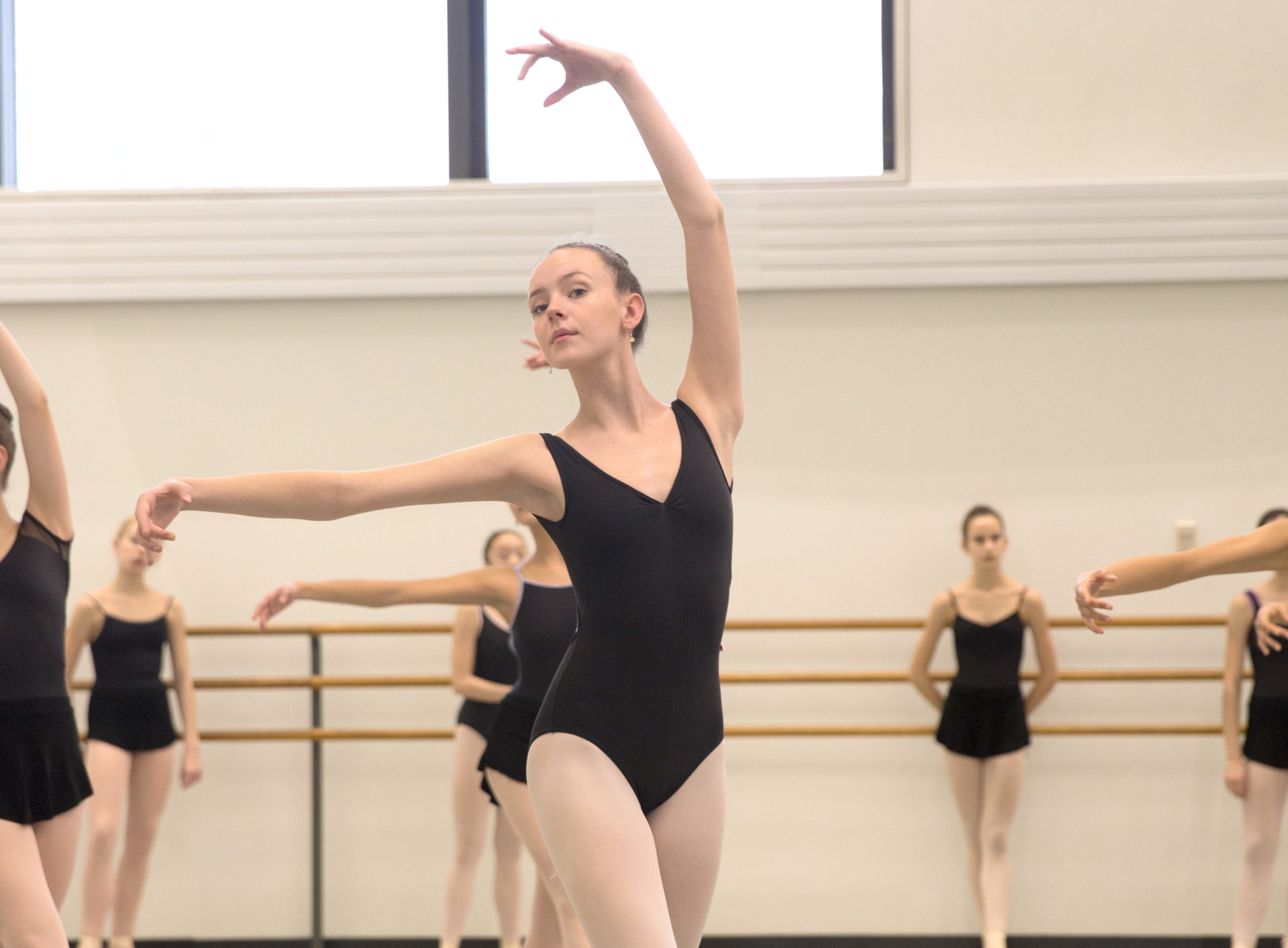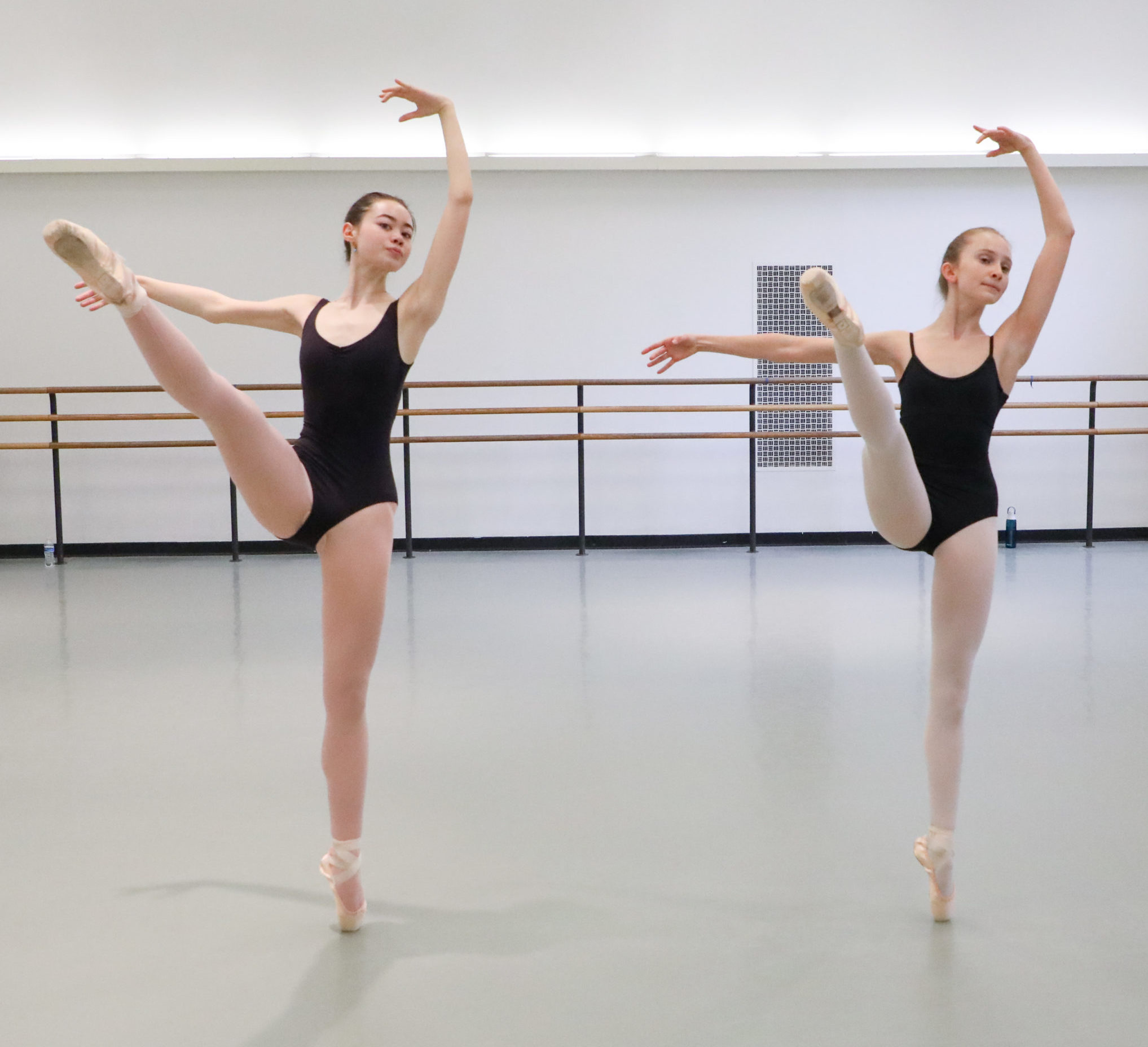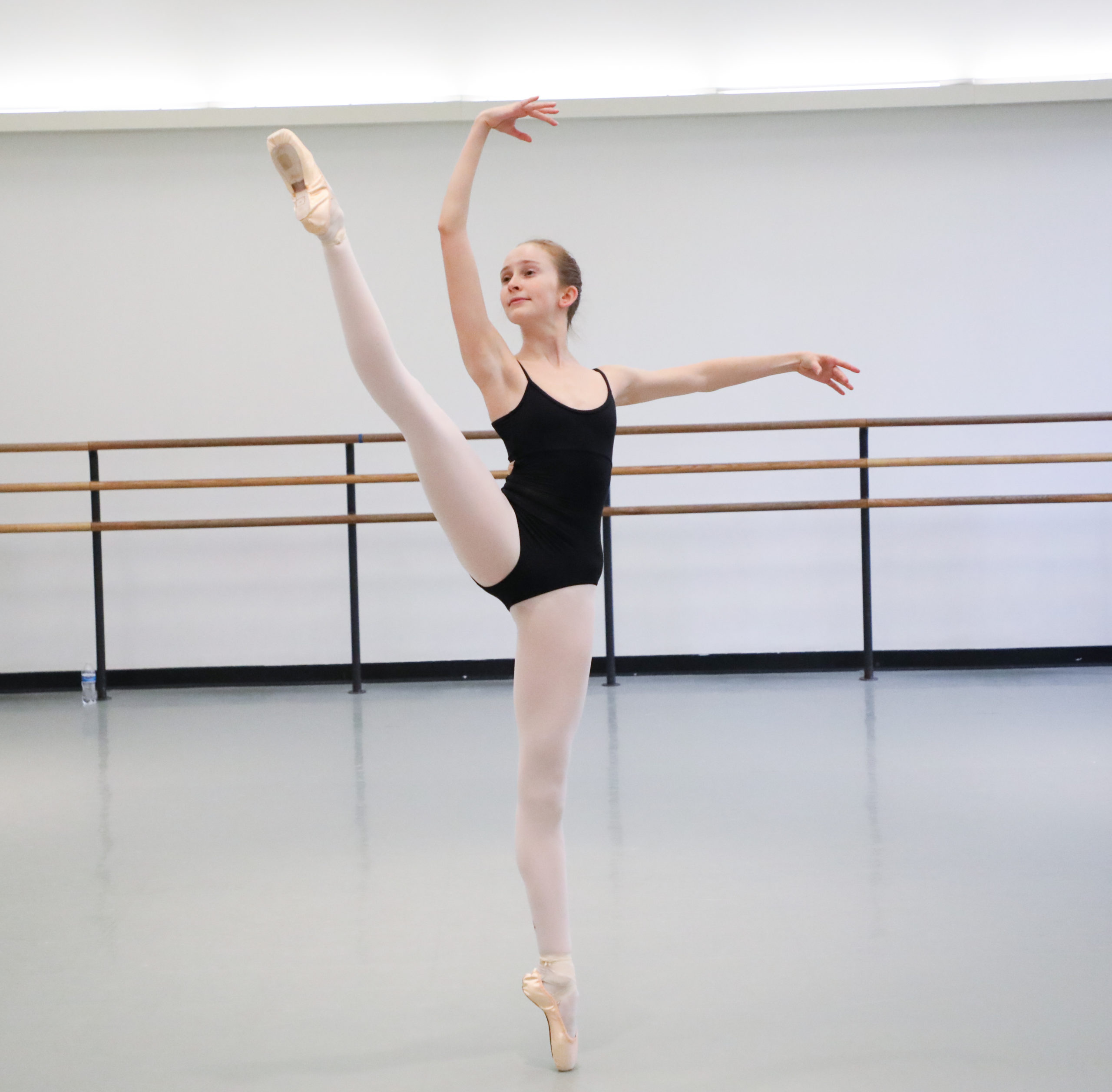We continue our excerptions from Suki Schorer on Balanchine Technique with a distillation of the chapter on épaulement as it relates to the orientation of the body to the front. In this section, Ms. Schorer breaks down the specifics of one’s orientation as it applies to four main positions – en face, croisé, effacé, and écarté – in relation to the front, or the audience.

The point of changing the orientation of the dancer’s body to the front – that is, to the audience – is, of course, to multiply the available looks, making the dancer and the dancing more interesting and more beautiful. The audience sees her straight on, front and back, in profile, and at angles in between. Balanchine worked to enhance this effect by ensuring that each dancer knew the location of her own front, side, and back (referred to as her directions). Since these refer to her own body and remain the same no matter how she is oriented in the room or to the public, each orientation of her body in the room has its own very distinctive look (i.e., each change in the direction she faces produces a change in the way she looks). And Mr. B set our exercises with very specific orientations (épaulement) of the body and positions of the head, arms, legs, and feet to help us acquire muscle memory. We became more aware of the differences among the positions and orientations so we could show each of them clearly in class and, more importantly, make them all legible onstage.
There are systems for numbering the corners and sides of the stage (and the corresponding points in the studio or classroom), but Mr. B never used them, preferring instead simply to show what he wanted. What he wanted most importantly is that each dancer be precise with reference to herself. If she did tendu front standing en face, her pointe was on her center line, extended directly in front of her. If she did tendu front standing in croisé, her pointe was still on her center line, directly in front of her, because her own directions are the same no matter where she is. Her pointe in croisé might aim precisely for the corner, but it might not. That depended on her exact location in the room or on stage (and the room or the stage being perfectly square). In either case, Mr. B wanted her pointe directly in front of her own center. The dancer needs to carry that awareness of her directions within herself and then apply it. Perhaps that is why he did not emphasize memorizing any of the numbering systems based on the space (studio or stage), rather than on herself.
En Face

En face is the purest orientation because the dancer is most fully revealed. It is also the simplest. Young children begin learning center port de bras standing en face. There is no camouflage: no épaulement, no curve of the neck, no slant of the head. Everything shows, making the dancer more vulnerable. And yet she must still look beautiful as she moves…
Mr. B did not make a lot of use of en face when we really moved or in his ballets. However, he gave us a variety of mostly stationary exercises en face to practice positions and ports de bras in which the dancer will be especially aware if she is not correct, such as lifting the arms from fifth low to first (to the “hug a tree” position) and then opening to second (like “parting the curtains on the Mediterranean Sea) as mentioned in an earlier section of the book. (p.152-154).] He also gave us smaller movements, such as piqué walks and tendus, and a few bigger ones, such as grand battement and développé, for which precise knowledge of front, side, and back were particularly important.
Croisé

Mr. B taught a technique for the neck and head in croisé that added greatly to the aesthetic beauty and distinctiveness of the orientation. In his croisé the dancer’s head and gaze are directed as is usual to the downstage shoulder, generally toward the corner. The dancer can see herself in the mirror. However, the neck curves and the top of the head slants toward the downstage shoulder, thereby bringing the ear toward it. The head is usually level or very slightly tilted up; the chin is not thrown back, nor is it tucked. The effect is to bring the cheek forward, presenting it to the audience.
“Ask for a kiss,” Mr. B would say.
This technique produces in the dancer the feeling of a gracious curve from the top of the head along the neck and down into the upper chest… This placement of the head is deceptive in its simplicity. Achieving the skill and flexibility to move smoothly in and out of the line Mr. B wanted takes regular practice, sometimes only moving the head and neck…This is the croisé that Balanchine used most often in choreography and that we practiced most frequently in class: body straight, working leg directly front or back, neck curved, head slanted, up-stage arm in a fifth, framing the face (meaning the hand is toward the front of the head, rather than pulled to the back) so the fingertips are over the center line of the head.
|
Essential Details in Croisé
The legs remain in the same relation to one another no matter the direction in which the body is turned (i.e., working leg directly front or back, toes on the center line of the body)
A correct curve of the neck and slant of the head
Fingertips over the center line of the head, framing the face, not pulled back away from the face; the arm in second is not pulled behind the torso
Torso straight, not inclined, unless the exercise is specifically set that way
In the croisé variant, the head is slanted away from the upraised downstage arm and toward the upstage shoulder
|
Effacé

The underlying principles for the use of the neck and the placement of the head that are used in standard croisé also apply to standard effacé. The head is again turned in the direction of the downstage shoulder and it is slanted, bringing the ear toward that shoulder. The neck is again curved, bringing the cheek forward. In effacé the head is usually lifted gently up.
The lift of the head is very slight in standard effacé. The face is raised just enough to direct the gaze up and out to the front, past and in front of the upper arm or elbow of the downstage arm, which is raised in fifth high. If the working leg is lifted close to ninety degrees or higher, the face can be raised a little more, so the gaze is directed past and in front of the forearm. The fingertips of the raised hand are over the center line of the head. The body remains straight in Mr. B’s standard effacé front and back; just as in his standard croisé, the body is not tilted forward and back. However, he also could use a slight cambré back in effacé when that gave the look required; it is often seen when the dancer tombés over and off pointe or off demi-pointe.
|
Essential Details in Effacé
The toes of the working foot are on the center line of the body when front or back
The hips are level and square to the dancer’s torso when the leg is in front
The chest is open; the neck is curved and the head is slanted, with the cheek brought forward. The head is not pulled away from the audience – “offer the cheek”
The fingertips are over the center line of the head, framing the face, not pulled back, away from the face
The arm in second position is not pulled behind the torso
In standard effacé maintain a straight, pulled-up body; do not tilt back or forward
|
Écarté

Although dancers and teachers have traditionally defined écarté largely in reference to the corners, Mr. B liked to say,
“Écarté is a position, not a place on the floor or in the corner; it can be done in any direction.”
…In traditional écarté, which Mr. B often used in the center, the dancer is on a diagonal once again and is seen with her hips and shoulders facing a diagonal, the orientation that is familiar from croisé and effacé. However, the feeling is quite different. In croisé and effacé the working leg is front or back, and the upper body shows curves. Both characteristics give it depth; they give a three-dimensional look. But in écarté the working leg is directly side and very turned out and, except for the lifted chest, the dancer feels almost two-dimensional. She should feel as she would if she were standing with her legs and hips pressed against a wall. Mr. B made it clear by walking to the front and assuming écarté tendu flat against the mirror: “Ecarté is a very flat position.”
For traditional écarté devant the working foot is on the downstage side. The torso is very erect, the downstage arm is raised in fifth high, and the up-stage arm is opened to second. The head is turned far enough to the side and is tilted so the gaze is upward. behind the forearm of the downstage arm. If she could see herself in the mirror, Balanchine told her, “You are already wrong!” because her head was not in the correct line. For traditional écarté derrière the upstage foot becomes the working foot, and the arms are reversed. However, the gaze remains generally downstage, on the diagonal that is, over the downstage arm and hand, which are extended in second. In écarté derrière the dancer may incline her torso gently away from the working leg, especially when the working leg was raised carté to ninety degrees or higher. The shoulders and head are tilted away from the raised working leg in écarté derrière, so the dancer’s head is also slightly slanted and the gaze is along the line of the arm in second. The fingertips of the hand raised in fifth high are over the center line of the head.
In class, dancers always display a proud, upright bearing, but this quality is especially important for écarté. Mr. B called écarté regal; I tell my classes to picture a queen with her chest lifted and open, holding her head up, as if wearing a high ruff on her neck.
|
Essential Details in Écarté
If the dancer looks at herself in the mirror in écarté devant, she is already wrong; her head is lifted and turned so her gaze is directed behind her arm and upward
Maintain a well turned-out, almost extreme, à la seconde (feel the thigh, knee, and foot behind the arm and in line with or behind, not in front of, the shoulder)
In écarté the chest is lifted up and open, the look is regal
The fingertips of the hand in fifth high are over the center line of the head
|
(Schorer, 1999, p.169-178)
Schorer, S., Lee, C. R., & Rosegg, C. (1999). Suki Schorer on Balanchine Technique. A.A. Knopf.







